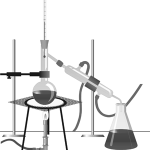With most folks looking to the sky this evening, lets take a quick look at the science behind the colors.
The colors you see in the sky are created by electrons. Every atom has a cloud of electrons circling the nucleus in what are called orbitals. Generally the electrons settle in the orbitals closest too the nucleus. However, they can sometimes absorb energy, and move to an excited state, and thus move to an orbital further from the nucleus. Eventually the electron will drop back down and release electromagnetic radiation, sometimes in the form of light in the visible spectrum.
Each element has its own fingerprint with regards to the wavelength of light that is emitted, and can be used to determine the color packed in the firework.
Although there can be a discussion of propellants and oxidizers, the focus here is just on colors and effects. So how do they get the colors in your favorite explosion?
- Aluminum - Used to produce silver and white flames and sparks. It is a common component of sparklers.
- Antimony - Creates glitter effects.
- Barium - Creates green colors in fireworks, and it can also help stabilize other volatile elements.
- Calcium - Calcium is used to deepen firework colors. Calcium salts produce orange fireworks
- Copper - Copper compounds produce blue colors in fireworks.
- Iron - Iron is used to produce sparks. The heat of the metal determines the color of the sparks.
- Lithium - A metal that is used to impart a red color to fireworks. Lithium carbonate, in particular, is a common colorant.
- Magnesium - Burns a very bright white, so it is used to add white sparks or improve the overall brilliance of a firework.
- Sodium - Imparts a gold or yellow color to fireworks.
- Strontium - Strontium salts impart a red color to fireworks.
- Titanium - Titanium metal can be burned as powder or flakes to produce silver sparks.
- Zinc - Used to create smoke effects for fireworks and other pyrotechnic devices.
